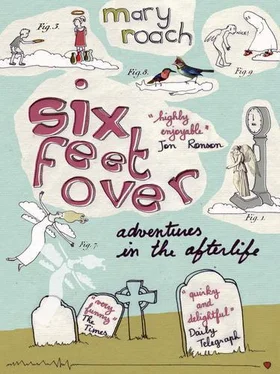Medical treatises were eminently more readable in Sanctorius’s day. Medicina statica delves fearlessly into subjects of unprecedented medical eccentricity: “Cucumbers, how prejudicial,” “Phlebotomy, why best in Autumn,” and the tantalizing “Leaping, its consequences.” There’s even a full-page, near-infomercial-quality plug for something called the Flesh-Brush.
Astoundingly, Sanctorius was described as a small man. His work habits may explain his ability to stay slim in an era of eight-pound dinners. He claimed to have tested ten thousand subjects over twenty-five years.
Credit for the original seal-a-soul-in-a-box experimental format must go to Frederick II, the thirteenth-century King of Sicily and Emperor of the Holy Roman Empire. In the diaries of the king’s sometime chronicler, the Franciscan monk Salimbene, there is a description of Frederick shutting up “a man alive in a cask until he died therein, wishing thereby to show that the soul perished utterly.” Though Frederick is to be credited for his precocious enthusiasm for scientific method, the cruelty of his experiments invariably outweighed their scientific merit. To wit, the time he “fed two men most excellently at dinner, one of whom he sent forthwith to sleep, and the other to hunt; and that same evening he caused them to be disemboweled in his presence, wishing to know which had digested the better” (the sleeper). At least that one makes some sense.
Anecdotal data on this matter comes from a former nurses’ aide named Juli Pankow, who e-mailed me regarding her observation of what she took to be the soul of a dying nursing home patient. The room was dark. She had just heard the woman’s death rattle. “There was a greenish-purple very very faint cloud or haze right above the chest.” From a Google search, I learned that exploded barium can appear as a greenish-purple cloud, though the cloud in question was linked to a NASA project, not post-barium-enema gas, so who knows.
In reality, an X-ray of the head could not show the brain, because the skull blocks the rays. What appeared to be an X-ray of the folds and convolutions of a human brain inside a skull—an image that circulated widely in 1896—was in fact an X-ray of artfully arranged cat intestines.
To those who find humor in this poor man’s name, I have this to say: His full name was Homer Clyde Snook.
I’m trying to work out how this makes sense as a noun meaning “the product of a bowel movement.” This is not Dawson’s personal euphemistic misstep; the usage persists in medical writing today. Should you have had the misfortune of visiting a web page called the Constipation Page, you will have seen the phrase, “the motion or stool is very dry or hard.” Perhaps this is why the term “motion pictures” was replaced by “movies.” Now that I see it on the page, “movie” would have been a far better BM euphemism than “motion.” I’d love to chat, but I need to make a movie .
I am an unabashed fan of the SPR (which has been around since 1882) and in particular its quarterly journal. Here are peer-reviewed articles addressing in all seriousness the likes of wart-charming and talking mongooses. Here are time-domain analyses of table rappings and field studies of healers’ effects on lettuce seed germination (“Figure 2: the healer ‘enhances’ the seeds, mimicked by the control healer”). I take it as nothing beyond happy coincidence that the SPR membership roster has at one time or another included a Mrs. H. G. Nutter, a Harry Wack, and a Mrs. Roy Batty.
Often the medium was using her foot to manipulate the furniture. However, Spirit Table Lifting aids were available for $12 by mail-order through the likes of the Ralph E. Sylvestre Company (“our effects are being used by nearly all prominent mediums,” brags the 1901 catalogue). Other helpful items included Telescopic Reaching Rods, self-playing trumpets, and Luminous Materialistic Ghosts (“appears gradually, floats about room and disappears”).
They did not, however, shew the way to a new theory on royalty rates. Dutton courteously rebuffed Crawford’s request to double his royalties to 20 percent.
Gynecological preoccupations are a running theme with the Princedom of Wales. Two and a half centuries later, the Prince of Wales would be caught in an intercepted cell phone call voicing his desire to be reincarnated as his lover’s tampon.
The man-midwife, with his arsenal of forceps and knives, was a recent arrival on the obstetrical scene and much resented by the gentle guild of midwifery. “Yea, infants have been born alive, with their brains working out of their heads, occasioned by the too common use of instruments,” warned midwife activist Sarah Stone in her 1737 A Complete Practice of Midwifery .
As opposed to the Swallowing Center at Northwestern, or the Swallowing Center at the University of Southern California, or the one at Holy Cross, or the Rusk Institute, or the Nebraska Medical Center. Of course, the original “swallowing center” is a chunk of your brainstem that coordinates chewing, gagging, vomiting, coughing, belching, and licking, all with minimal fuss and no funding from the NIH.
I once saw a wax model of a horned human head at the Mütter Museum in Philadelphia, but I had no idea the condition was sufficiently common for a doctor to pull together one hundred cases for a review paper. But what do I know? Perhaps horns were the plantar warts of their day. Perhaps Sachs held a post at the Horn Center at the University of Padua.
Where, says the school’s vice president for research, “professors are allowed to pursue their own interests as long as there’s nothing unethical or illegal.” It’s a sentiment echoed by the powers-that-be at no less than Harvard Medical School, which counted as faculty the late alien-abduction researcher/sympathizer John Mack. “Oh, they’re all weird or embarrassing one way or another,” said a spokesman some years ago when I expressed surprise at Mack’s tenure. “Besides,” he added ominously, “there’s a lot of weird science that turns out to be not-so-weird once it’s proven.”
Schwartz’s $1.8 million NIH grant, of which the university takes fifty-one percent, helps ease any discomfort over the lab’s unorthodox research.
The Donner Party spent the winter of 1846–47 stranded near Donner Lake, in the Sierras of California. When it became clear there wasn’t food to last the winter, seventeen of the strongest set out to get help. Another blizzard hit, stranding the rescue party at what came to be called the Camp of Death. The flesh and organs of four who died there—though not, I am relieved to report, the man named Mr. Burger—gave the others the strength to make it over the mountains. Lest you doubt the direness of the situation, a quote from Unfortunate Emigrants: “January 1, 1847. They made their New Year’s dinner of the strings of their snow-shoes. Mr. Eddy also ate an old pair of moccasins.” By the time help arrived, four months hence, most of those left alive had resorted to the food that knows no cookbook.
It’s possible that the history of creatively interpreted white noise dates as far back as the Oracle at Delphi, where the priestess sat above a crack in the temple floor, below which could be heard the roiling waters of a spring. Dean Radin, senior scientist at the Institute of Noetic Sciences, has posited that the white-noise-like sounds of the water may have brought on auditory hallucinations. (The more common theory holds that ethylene fumes issuing from the spot were sponsoring the woman’s altered state of mind. Ethylene—better known for making bananas ripe than for making priestesses bananas—can cause hallucinations in concentrated amounts.)
Читать дальше











